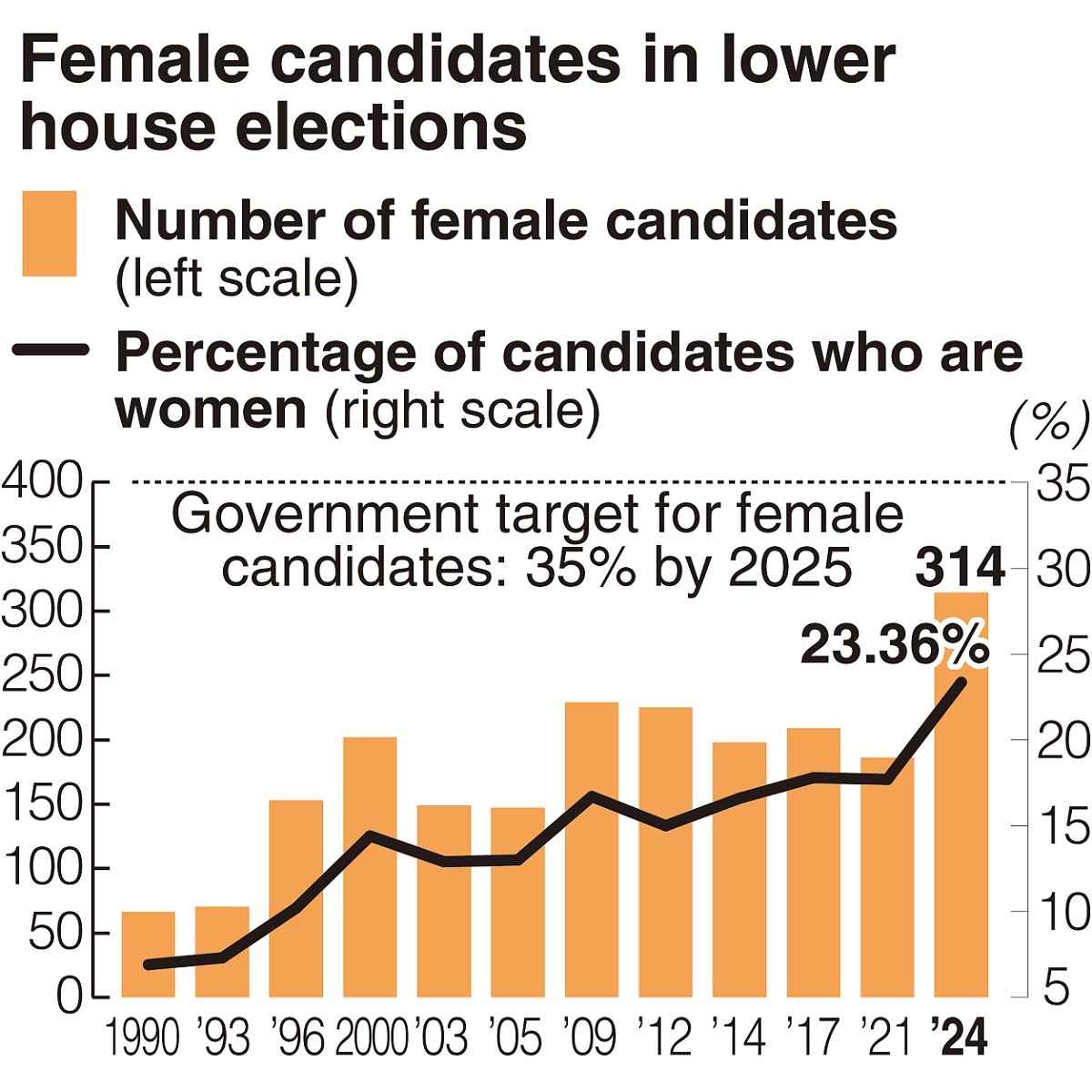Japan Election: 23% of Candidates in Lower House Race Were Female; Number Still Falls Short of Government’s 35% Target

A female candidate waves to the audience during a street stump speech in Tochigi Prefecture on Tuesday.
16:06 JST, October 27, 2024
Of the 1,344 candidates in the recent House of Representatives election, 314 were women, the highest number ever. The proportion of women among all the candidates reached a record of 23.36%, but it is still far short of the government’s target of 35% by 2025. Although each party has pledged to increase the number of female lawmakers, there are still many obstacles facing women who take on the challenge of national politics.
“Doesn’t it matter if women’s voices don’t reach the Diet?” said one female candidate in her 30s, running in a constituency in Tochigi Prefecture. As she shouted to the audience, she received a burst of applause in response.
About 10 years ago, a female executive at her company told her, “Women are not recognized as full-fledged workers unless they work three times as hard as men.” The now candidate worked very hard, but she became mentally and physically ill and shut herself away from society.
She moved to Tochigi prefecture, where her health rebounded as she interacted with the local people. She decided to run for office, saying, “I want to give back to the community.”
She listened to the concerns of her supporters, who told her things like, “My relatives told me that women do not need to go to university.” Thus, she became strongly aware of the stereotypes in society that prevent women from being active in their communities. “They make people believe that ‘women cannot be leaders because they are not capable,’” she said. “That keeps the number of women wanting to enter politics from increasing.”
Women’s participation in politics has been an issue for long time.
In 2018, the Act on Promotion of Gender Equality in the Political Field was enacted, with the intent of equalizing the number of male and female political candidates in each party, and in 2020, the government set a target in the Fifth Basic Plan for Gender Equality to increase the proportion of female candidates for the lower house to 35% by 2025.
Each party has implemented measures such as subsidizing babysitting expenses and establishing points of contact to report harassment. In this election, the parties also actively fielded women candidates, along with making pledges to raise the ratio of female lawmakers and to introduce a quota system to allocate a certain number of candidates and seats to women. 314 women ran for office, surpassing the record of 229 set in 2009.
However, women remain only a little over 20% of all candidates, and it is still difficult for them to run for office.
In 2022, the House of Representatives asked all members of the lower house about the participation of women in the Diet, and 48% of respondents said it was being prevented from increasing. The percentage was over 70% among female lower house members.

Opinions given by respondents included, “women are burdened with domestic responsibilities such as housework, childcare and nursing care,” and “grassroots election campaigning consumes time and energy and puts women at a disadvantage,” giving a glimpse of the reality that social incomprehension and prejudice prevent women from participating in politics.
In the House of Representatives, in particular, the percentage of women was 10% before the dissolution, lagging behind that of the House of Councillors at 26%, prefectural assemblies (11.8%) and municipal assemblies (15.4%).
One female candidate from an opposition party sheds light on the atmosphere within her party: “A member of the House of Representatives who belongs to a political party is tacitly understood to be the leader of the party’s organization in each area. I feel that political parties are reluctant to appoint women as leaders.”
Reiko Oyama, professor emeritus at Komazawa University, said: “The ‘politics and money’ issue seems to have cast doubt on the ruling parties’ sense of stability in this election, which may have led to many female candidates being drafted, creating a sense of reform. Efforts to encourage an increase in the number of female Diet members, such as paying more political party grants to parties with more female Diet members, could also be effective.”
"Politics" POPULAR ARTICLE
-

Japan to Support Central Asian Logistics Route That Bypasses Russia, Plan to Be Part of Upcoming Summit in Tokyo
-

Japan to Tighten Screening of Foreigners’ Residential Status by Providing Information of Nonpayment of Taxes
-

Chinese, Russian Bombers Flew Unusual Path by Heading Toward Tokyo; Move Likely Meant to Intimidate Japan
-

Japan Plans National Database to Track Foreign Ownership of Real Estate, Land as It Weighs New Rules
-

Up to 199,000 Deaths Estimated From Mega-Tsunami; Most Recent Occurrence Took Place in 17th Century
JN ACCESS RANKING
-

Tokyo Economic Security Forum to Hold Inaugural Meeting Amid Tense Global Environment
-

Keidanren Chairman Yoshinobu Tsutsui Visits Kashiwazaki-Kariwa Nuclear Power Plant; Inspects New Emergency Safety System
-

Imports of Rare Earths from China Facing Delays, May Be Caused by Deterioration of Japan-China Relations
-

University of Tokyo Professor Discusses Japanese Economic Security in Interview Ahead of Forum
-

Japan Pulls out of Vietnam Nuclear Project, Complicating Hanoi’s Power Plans



























